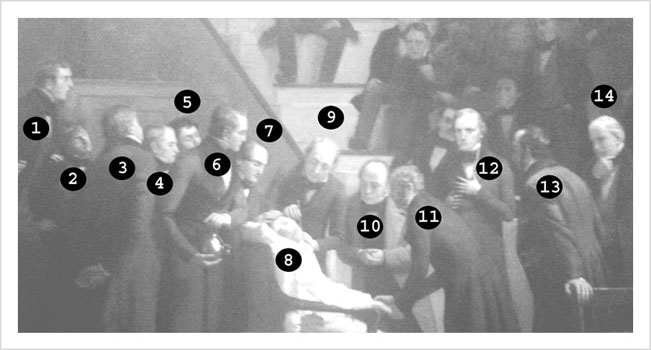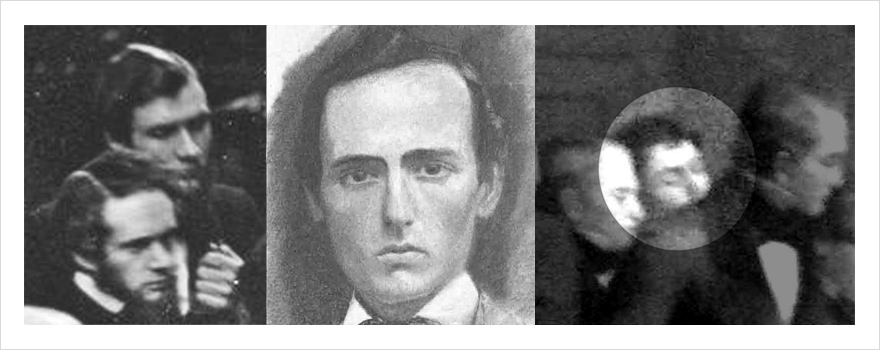

Identities of the subjects in Hinckley's painting of the Abbott surgery, according to Dr. Henry Rouse Viets: 29 1.) Newspaper reporter. 2.) John Call Dalton. 3.) William Williamson Wellington. 4.) Abel Lawrence Peirson. 5.) Charles Hosea Hildreth. 6.) William Thomas Green Morton. 7.) Jonathan Mason Warren. 8.) Gilbert Abbott. 9.) John Collins Warren. 10.) Eben H. Frost. 11.) Charles Frederick Heywood. 12.) Henry Jacob Bigelow. 13.) Augustus Addison Gould. 14.) Solomon Davis Townsend.
The only artist's representation of the Abbott operation that includes an MGH staff physician – aside from the unpublished proof states of Hall's engraving – is Robert C. Hinckley's monumental painting, "The First Operation with Ether," completed c1893. A young bearded doctor is seen bent over Abbott, clasping his hand and wrist to monitor his pulse rate and blood pressure. The presence of a staff physician during surgery was advisable, both to liaise with the medical wing of the hospital and to monitor a patient's vital signs, duties that were especially critical for the experimental first ether operations. Historical accounts name only Charles Bertody fulfilling this function for the Abbott operation, however, the medical historian Dr. Henry Rouse Viets mistakenly identified House-surgeon Charles Frederick Heywood as the monitor, published in a seven-page pamphlet distributed to attendees of an exhibition of Hinckley's painting at the 181st annual meeting of the Massachusetts Historical Society, May 22-24, 1962. His pamphlet was illustrated by a schematic that was captioned with his attributions for each subject in the painting. The Viets pamphlet has long since disappeared from circulation, but a thorough discussion of its contents and a reproduction of the schematic can be found in Richard Wolfe's extensive monograph on the Hinckley painting and is the resource for the commentary that follows.(24)
Wolfe published and discussed in depth Hinckley's suite of ten charcoal wash sketches that were his preliminary studies for the principals of the Abbott operation. Similar to the forensic composites used by police in their fieldwork, these sketches enabled Hinckley to solicit opinions on identities while he was researching his painting. I believe one of these drawings, inscribed with the names "Beckwith" and "Dresser," was copied after Figure 10 (Daniel Denison Slade) in the "reenactment" daguerreotype.(25) If I am right, then Hinckley's rendering of Figure 10 would explain the odd angle of the jaw and the skewed halves of the face in his sketch. It requires a keen eye and fastidious workmanship, yet an experienced visual artist is quite capable of reading and pivoting the linear perspectives of a photographic element, whether it's a nose, jaw, ear, or profile. The figure in Hinckley's painting who Viets identified as Hildreth, appropriates the staging of Figure 10, matching a shadowy lock of hair over his forehead and the tilt of head as he peered over the shoulder of Gould to get a better view of the patient.

Comparative images of Hinckley's subject who can be identified as Dr. Daniel Denison Slade. Left panel: view of Drs. Slade (top), and Heywood (bottom), from the reenactment daguerreotype. Center panel: detail of Hinckley's preparatory study for his painting of the Abbott operation. Archived at the Countway Library. Right panel: detail of Slade's profile in Hinckley's painting.
Hinckley may have applied the same anamorphic strategy for his sketch inscribed, "Heywood," by realigning linear perspectives and copying the features of Figure 3 in the "reenactment" daguerreotype, or maybe the features of the etherizer (Bigelow) in EDD Nos. 2-5, or even both? The drawing is less successful, however, and maps out like a caricature. The only figure in Hinckley's painting who bears any resemblance to the sketch of Heywood is the figure Viets identified as Dalton, and certainly not the bearded House-physician. Viets's more contentious attributions were sourced from the Rice book, which erred by omitting Heywood and Bertody from the inner circle, but included Peirson, Jonathan Mason Warren, William Wellington (present but not a principal), and George Hayward.(26 »») Bertody left Boston to join the 1849 California Gold Rush and was not available to sit for a portrait or to authenticate his role in the Abbott surgery, which could explain why Rice omitted his name. Left unexplained, is how or where Hinckley found his model for the bearded House-physician, although it would not surprise me if it's an abstraction of Figure 1 in the "reenactment" daguerreotype.
And faulty logic has led to Parkman being misidentified as Bigelow by Viets and others, but confirmed by Bigelow himself who wrote to Hinckley, "..they [Townsend and Hayward] & Parkman are in perspective." Bigelow complained to Hinckley about the delineation of his height on the canvas, providing more than enough evidence to refute Viets's a priori suppositions. Given Bigelow's importance in the Abbott surgery it really ought to be his head, not Parkman's, on the figure standing next to Townsend, with hands clasped to his chest. Dispensing with everything that has been written on Hinckley's painting, and going just on my visual impressions derived from the Ether Dome daguerreotypes, I would rewrite Viet's caption with the following correctives: 2.) Charles Frederick Heywood, tasked to run errands and take notes for the MGH records. 3.) Originally intended to represent Augustus Addison Gould, standing shoulder to shoulder with Morton, but later swapped to represent Bigelow for reasons unknown. 4.) Henry Jacob Bigelow, as portrayed in the daguerreotypes, but with a much too diminutive stature in height and importance. 5.) A generic student modeled after Slade. 11.) In reality Charles Bertody, but probably Hinckley's idealization of a House-physician, modeled after Figure 1. 12.) Samuel Parkman, as portrayed in the 1853 "Holmes and the Boston Society for Medical Improvement" group photograph. 13.) George Hayward, a visual trope representing his succession to the MGH chair of surgery.(27)
24.) Wolfe, RJ (1993), "Robert C. Hinckley and the Recreation of The First Operation Under Ether." Boston: The Boston Medical Library in the Francis A. Countway Library of Medicine; Illustration 5, p. 31. Wolfe is the current source in print for excerpts from Dr. Viets's pamphlet, "Hinckley's who was who on Ether Day: An Exhibit," (Boston: 1962).
25.) Ibid; p. 45-53. Holograph notation reads: "[William Clark] Beckwith" and "[Jacob] Dresser." The sketch is one of ten "Studies for the First Operation under Ether" that Hinckley gifted to Harvard in 1934 and are now archived at the Countway Medical Library in Boston.
26.) Rice, N (1859); p. 94.
27.) Wolfe, RJ (1993); See Wolfe's theory, page 79, on Hildreth's face as a prototype for Bertody in the figure I identify as modeled after Slade, "simply because his [face] was available and Bertody's was not." Slade did not attend the Abbott operation and Hildreth sat in the bleachers. Two of Hinckley's ten charcoal sketches are of Hildreth, who was one of Hinckley's correspondents and may have pushed his way onto the canvas. Regarding my other attributions, I believe Viets missed the visual metaphor of Dr. George Hayward, who is depicted as the next occupant of the chair of the surgical department at MGH. Viets's identification of Parkman as Bigelow is clearly wrong, though the figure's face doesn't quite match Parkman's angularity. Bigelow corresponded with Hinckley and sent diagrams for guidance that confirm my attributions for Parkman and Hayward; see Wolfe p. 70-71 for the quote. Bigelow also complained to Hinckley about the height and "ewe neck" of his portrayal. Besides the compositional failure of Bigelow's portrayal, given his importance in the ether saga, Hinckley's portrayal of J. Collins Warren doesn't quite measure up to the great surgeon's powerful visage and commanding presence.
